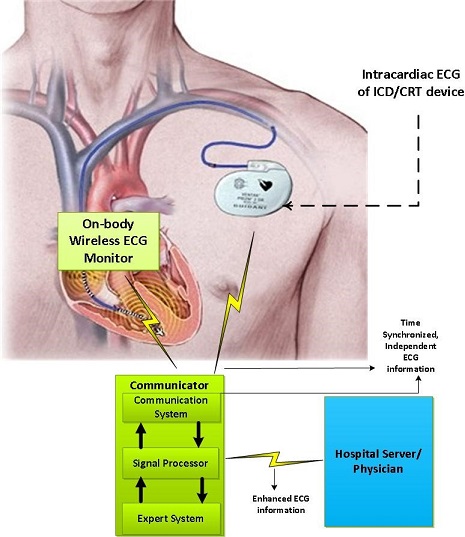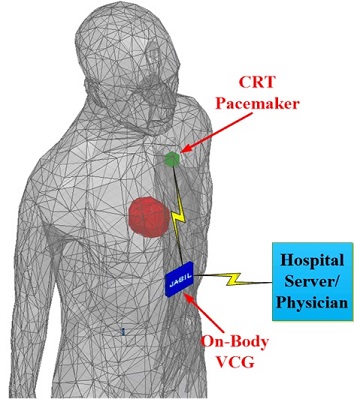The Biomedical Wireless Information Networking research program is directed towards using wireless and learning systems technologies to advance the state-of-the art in biomedical devices. The current focus is on novel cardiac rhythm devices, such as the iCRM and the vectorcardiogram (VCG).
The electrocardiogram (ECG/EKG) is an electrical representation of the polarization cycle of the heart as read by electrodes placed at strategic points on the skin surface. The heart is stimulated by the natural pacemaker of the heart, which applies an electric current to the heart such that the muscles of the heart (coronary muscles) contract. An ECG helps to present an accurate picture of the health of the heart. In a similar fashion, an Intracardiac ECG is embedded in a pacemaker. This ECG monitors the heart for possible arrhythmias. The leads are placed inside the heart and send information, (a set of voltage measurements) over a period of time, to the implanted device.
iCRM
The intent of the Innovative Cardiac Rhythm Management [iCRM] research program is to build a system that uses and enhances existing technology to provide physicians with additional, valuable information about their patients, both in a real time and in a remote manner. The system is shown in the figure below and includes: (i) an on-body wireless electrocardiogram or Wireless ECG, (ii) an Intracardiac ECG embedded inside an artificial pacemaker device and (iii) a Communicator (with a resident Learning System). The first two devices are part of existing technology available in the market and are emulated using measured data from cardiac rhythm monitors, while the Communicator is designed and implemented by the research team. By combining the information supplied by (i) and (ii), both of which measure the electrical activity of the heart rhythm, the value of the total information presented to the physician will increase.

Using an ECG database containing surface and Intracardiac ECG records for patients undergoing arrhythmia, we have been able to develop superior learning algorithms that classify the arrhythmia with an accuracy of over 99%.
VCG [vectorcardiogram]
The VCG provides a 3D representation of the cardiac electrical field. More precisely, the VCG is an orthogonal lead system that reflects the electrical activity in the three perpendicular directions X, Y, and Z. For such a system, the interpretation is not confined to findings of the "gold standard"; 12-lead ECG. Additional information is acquired through the visualization of 3D loops together with its projection onto the YZ (frontal), XZ (sagittal) and XY (transverse) planes.
Our research involves miniaturizing the VCG and incorporating learning and wireless communication capabilities . The vCRM system is comprised of a VCG that is designed to be worn on the body, a Pacemaker (CRT), and an associated Server as shown in Fig.2. The vCRM enables, for the first time, comprehensive long-term information collection ["BIG DATA"], from an outpatient that is similar to that available from the 12-lead ECG, to be continuously received and processed.

Preliminary tests to measure the electrical activity of the heart for different distances are directed towards determining the minimum distance between two leads and help us determine the minimum physical dimensions of the VCG system.
Our Project Objective for 2014 is to design and realize an external on-body VCG and prototype associated products (vCRM) and our longer term vision is to realize an implantable VCG system.
